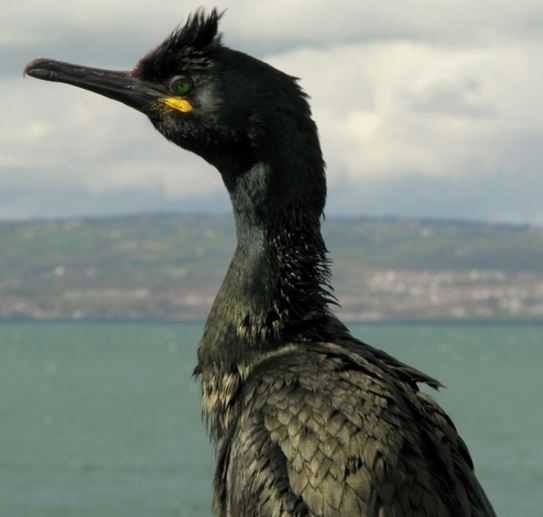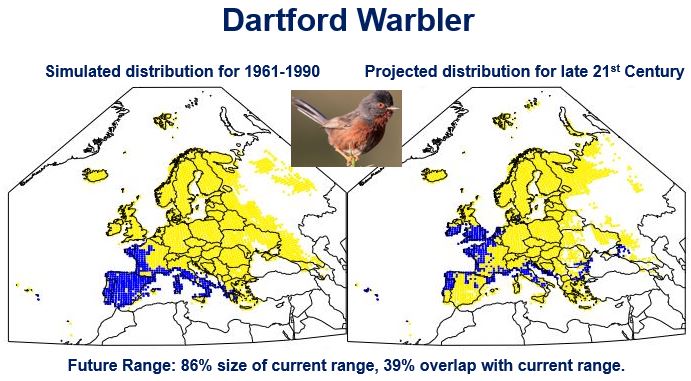UK wildlife is being damaged by climate change, says a new RSPB (Royal Society for the Protection of Birds) report, which adds that Europe’s wildlife is also being affected. The authors warn that over the course of this century, these effects will progressively intensify.
The RSPB report – ‘The Nature of Climate Change’ – reviewed and compiled current evidence showing that some of Europe’s most loved species of wildlife, from bees to birds, are already facing a serious risk from global warming. Sadly, this will get worse over coming decades.
A new poll found that the British public is more concerned about the effects of climate change on UK wildlife than any other of its impacts.
 The Kittiwake’s (above) major food source – sand-eels – are in trouble because the new plankton replacing the dying ones in the North Sea is much less suitable as a food source.
The Kittiwake’s (above) major food source – sand-eels – are in trouble because the new plankton replacing the dying ones in the North Sea is much less suitable as a food source.
RSPB’s Director of Conservation, Martin Harper, said:
“Climate change is the greatest long-term threat to people and wildlife. We are already seeing its impacts and, alongside other pressures on land and at sea, our wildlife is increasingly at risk.”
Compelling examples of harm to wildlife
The report contains the most compelling examples of how wildlife across the UK and Europe is already being damaged by climate change:
– Extreme Weather Events: have occurred much more frequently and severely due to the changing climate. The authors warn that this frequency will continue, with the intervals between every severe event becoming shorter. Weather extremes can be significantly harmful for wildlife.
Wet and windy springs, for example, can cause mass deaths of shags (goose-sized dark long-necked birds similar to cormorants). About 45% of the world’s shag population lives in the UK.
 Shag populations can be devastated if the spring season is very wet and windy. Due to climate change, these adverse conditions are becoming more common.
Shag populations can be devastated if the spring season is very wet and windy. Due to climate change, these adverse conditions are becoming more common.
Suitable Habitat: wildlife will only be able to thrive in a suitable climate if there is enough suitable habitat available. By the end of this century, one third of all bumblebee species in Europe could lose 80% of their current range.
Governments, local authorities and relevant agencies must make sure protected areas are better managed, as well as creating new protected areas. Measures must be taken to make the wider landscape more ‘wildlife- friendly’.
Divergence of Species: the location, numbers and timing of species are diverging. Climate change is altering sea conditions in the North Sea, with knock-on changes in plankton communities.
Of concern is that the incoming plankton species are much less suitable than those they are replacing as food for sand-eels – a small fish, which in turn is an important food source for kittiwakes (medium-sized gulls with a small yellow bill and a dark eye) and other seabirds.
The kittiwake population has declined by 70% in recent decades, and the RSPB says climate change is the main reason.
Wildlife Moving: – as the climate gets warmer wildlife is having to move to find the right environments – either uphill or northwards. Because of these changes, species are colonising new areas.
 Current and future potential distribution maps for the Dartford Warbler. Blue squares show where climate is suitable for the species to occur; yellow squares are where it is predicted to be absent. (Data Source: RSPB)
Current and future potential distribution maps for the Dartford Warbler. Blue squares show where climate is suitable for the species to occur; yellow squares are where it is predicted to be absent. (Data Source: RSPB)
More than 120 species have colonised the British Isles since 1900. Small red-eyed damselflies, first spotted in the UK in 1999, are now spreading across the country.
At the same time, some species are moving out of Britain, seeking cooler environments further north. Wildlife may be forced to migrate into areas where no suitable habitat is available for it.
Wildlife a top concern for Brits
The Energy and Climate Intelligence Unit (ECIU) recently commissioned a survey which showed that 79% of Britons are concerned about climate impacts on their country’s wildlife, meaning they are more worried about wildlife than flooding (72%), food prices (60%), and heat waves (50%).
Director of ECIU, Richard Black, said:
“It’s quite a surprising finding because you’d think people would be more concerned about potential impacts to their homes, their larders and their wallets.”
“Instead it shows that Britain’s long-standing love affair with birds, flowers and animals shows no signs of abating, and that recent studies demonstrating climate change impacts on animals such as puffins, bumblebees and frogs have raised the alarm.”
Another poll, carried out by the National Federation of Women’s Institutes (NFWI), had similar results.
NFWI Vice Chair and Chair of NFWI Public Affairs, Marylyn Haines Evans, said:
“WI members have a long history of environmental action since speaking out on the threats to our seas from pollution in 1927, and recent campaigns include calls to protect wildlife and the countryside, and to increase funding into honeybee research.”
“Climate change and its impact on future generations are real and growing concerns for members with 56 per cent most concerned about loss of UK wildlife, for example the ongoing threat to birds and bees, and 83 per cent agreeing that world leaders must urgently agree a deal to tackle climate change.”
Martin Harper added:
“The report has a clear message that the world’s governments need to act on fast, to limit climate change. They’ve no better opportunity to do this than the upcoming UN climate negotiations in Paris. Countries such as the UK also need to make sure they’re making every possible effort to back up international ambition with action back home, in part by supporting the transition to a low carbon energy system.”
“For wildlife to be able to cope with a changing climate, we’ll need to manage more areas of land and sea for nature, in both protected areas and the wider countryside and seas. There is good evidence that protected areas across the European Union, such as Special Protection Areas, are already helping wildlife to respond to the changing climate.”
“Projections show that protected areas will remain important for wildlife in the future, even as species move due to climate change, and that we will need more of them. The laws they rely on, such as the Nature Directives, need to be maintained and better implemented. This means designating more areas on land and at sea and managing them to a high standard for wildlife.”
A call on all Europeans to help
European leaders across the continent are currently trying the weaken the laws that protect our wildlife.
The RSPB is urgently calling on all Britons to add their voice to thousands of others and defend nature. SPEAK UP NOW!
Video – Giving nature a home
This RSPB video invites people to learn more about how they can give nature a home in their own gardens.
